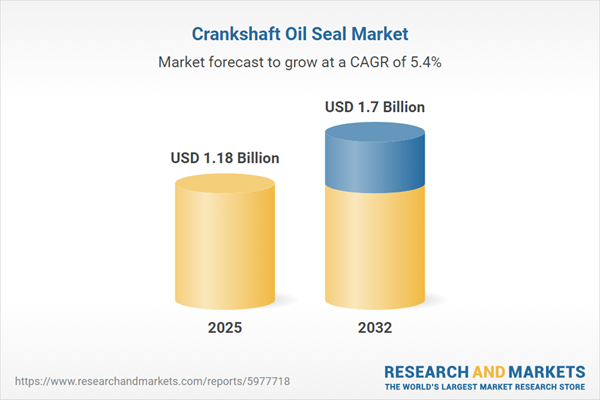Speak directly to the analyst to clarify any post sales queries you may have.
The crankshaft oil seal market is undergoing significant transformation, driven by stricter regulations, technological advances, and a renewed focus on resilient supply chain strategies. Senior leaders are placing greater importance on efficient seal procurement to ensure operational stability and compliance across diverse industries.
Market Snapshot: Global Crankshaft Oil Seal Market Size and Outlook
Demonstrating a strong growth trajectory, the global crankshaft oil seal market is experiencing increased demand from automotive, aerospace, and energy segments. Innovations in material science are enhancing seal durability and heat resistance, which enables broader application across industries with rigorous performance requirements. Organizations are ramping up investment in supply chain upgrades and research to meet growing expectations for compliance and prolonged seal life. These advancements have established crankshaft oil seals as important operational assets supporting continuous production and long-term equipment reliability.
Scope & Segmentation of the Crankshaft Oil Seal Market
- End Use Industry: Crankshaft oil seals are tailored to the specialized needs of aerospace, automotive, mining, oil and gas, power generation, and marine industries, each with sector-specific durability and lifespan requirements.
- Vehicle Type: Seal offerings address the operational demands of heavy-duty trucks, passenger cars, and light-duty trucks to meet varied transport network and fleet needs.
- Material: Key materials include fluoroelastomer, nitrile rubber, polyurethane, PTFE, and silicon, each selected for specific heat and chemical resistance properties that support reliability and operational compliance.
- Seal Type: Available formats include single lip, double lip, and multi-lip seals, all designed to prevent contamination and extend maintenance cycles in critical equipment.
- Distribution Channel: Organizations source seals through original equipment manufacturer (OEM) supply, aftermarket distributors, and digital as well as traditional procurement strategies, providing flexibility in global and local markets.
- Regions: The market covers the Americas, Europe, Middle East and Africa, and Asia-Pacific, with regional expertise required to navigate variable regulatory, environmental, and supply chain considerations.
- Companies Covered: Leading suppliers such as NOK Corporation, Freudenberg Sealing Technologies, SKF AB, Trelleborg AB, Parker Hannifin, The Timken Company, Dana Incorporated, JTEKT Corporation, MAHLE GmbH, and Cooper Standard Automotive influence standards, product innovation, and global distribution networks.
A robust understanding of these segments supports optimization of material usage, targeted supplier partnerships, and dependable sourcing strategies amid international compliance and supply risk pressures.
Key Takeaways for Senior Decision-Makers
- Advanced crankshaft oil seals contribute to reduced unscheduled downtime, supporting continuous production in sectors with strict operational requirements.
- Material innovations and integrated monitoring features are enabling longer service intervals, decreasing maintenance frequency across a range of industrial applications.
- Digital IoT-enabled solutions facilitate predictive insights, enabling strategic asset management and optimal timing for procurement and maintenance cycles.
- Adapting seal materials and custom supplier arrangements for regional conditions enhances risk mitigation and supports sustained cost management within fluctuating markets.
- Leveraging both digital and conventional sourcing strategies allows organizations to respond quickly to changes in procurement landscapes and maintain operational resilience.
Tariff Impact
Recent tariff adjustments in the United States are prompting market participants to reassess sourcing strategies. Greater reliance on domestic suppliers and a diversified supplier base have become key tactics for preserving flexibility and responding to regulatory changes. These adjustments are central to building stronger risk management processes and ensuring uninterrupted operations.
Methodology & Data Sources
Findings in this report are built on direct interviews with industry executives, procurement specialists, and engineers, complemented by international surveys and patent reviews. Continuous regulatory monitoring and live trade data analysis ensure all insights accurately reflect the latest market environment for crankshaft oil seals.
Why This Crankshaft Oil Seal Market Report Matters
- Provides actionable guidance for addressing regulatory changes and leveraging new technologies, enabling organizations to accelerate procurement strategies in the crankshaft oil seal sector.
- Maps supply networks and distribution channels, supporting strategic sourcing and fostering robust, long-term supply chain reliability.
- Enables decision-makers to proactively respond to emerging risks and regulatory trends, supporting sustained operations in unpredictable environments.
Conclusion
Utilizing next-generation materials and modern seal technologies, combined with resilient supplier networks, strengthens operational reliability and positions organizations for effective adaptation in a rapidly shifting crankshaft oil seal market.
Additional Product Information:
- Purchase of this report includes 1 year online access with quarterly updates.
- This report can be updated on request. Please contact our Customer Experience team using the Ask a Question widget on our website.
Table of Contents
3. Executive Summary
4. Market Overview
7. Cumulative Impact of Artificial Intelligence 2025
Companies Mentioned
The companies profiled in this Crankshaft Oil Seal market report include:- NOK Corporation
- Freudenberg Sealing Technologies GmbH & Co. KG
- SKF AB
- Trelleborg AB
- Parker Hannifin Corporation
- The Timken Company
- Dana Incorporated
- JTEKT Corporation
- MAHLE GmbH
- Cooper Standard Automotive Inc.
Table Information
| Report Attribute | Details |
|---|---|
| No. of Pages | 185 |
| Published | October 2025 |
| Forecast Period | 2025 - 2032 |
| Estimated Market Value ( USD | $ 1.18 Billion |
| Forecasted Market Value ( USD | $ 1.7 Billion |
| Compound Annual Growth Rate | 5.4% |
| Regions Covered | Global |
| No. of Companies Mentioned | 11 |









